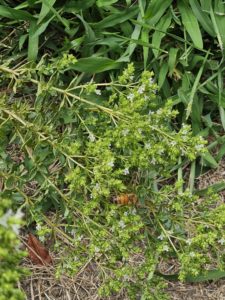
Ever since an immediate neighbor started using a mosquito and tick service last year, it is rare to find bees or butterflies in my organic yard and garden. Where I formerly had multitudes of bees, I now rarely see one.
This is because mosquito/tick services use pesticides that are highly toxic to bees and butterflies. The applicators hold pesticide sprayers at waist height that spray insecticides directly out at high volume, and usually walk along a property 's perimeter spraying.
Typically pyrethroid and cypermethrin insecticides (e.g. made by Fendona) are used. These are broad-spectrum (kill many species, including bees), microencapsulated, long-lasting (up to 90 days), and applications are every 3 weeks.
Yup, I observed the applicator walking along the neighbor's yard perimeter applying the insecticides at waist height directly into my hedges (it is obvious to the applicator that they are on my property). As he walked along, I could see the hedges violently shaking from the high volume application.
That is a deliberate non-target application of pesticides, which is against the law in my state. But it's what these companies do with impunity - go look at their web-site photos. By the way, pesticide contamination of adjacent properties will always be a problem in suburban yards with this kind of application.
Bees are pollinators, and unfortunately they are in serious decline in the United States. Pesticides are a big cause. Pesticides, including pyrethroids, also have numerous health effects on humans - none of them good. Especially worrisome is exposure during pregnancy or in young children.

A rare bee sighting among the oregano blossoms.
